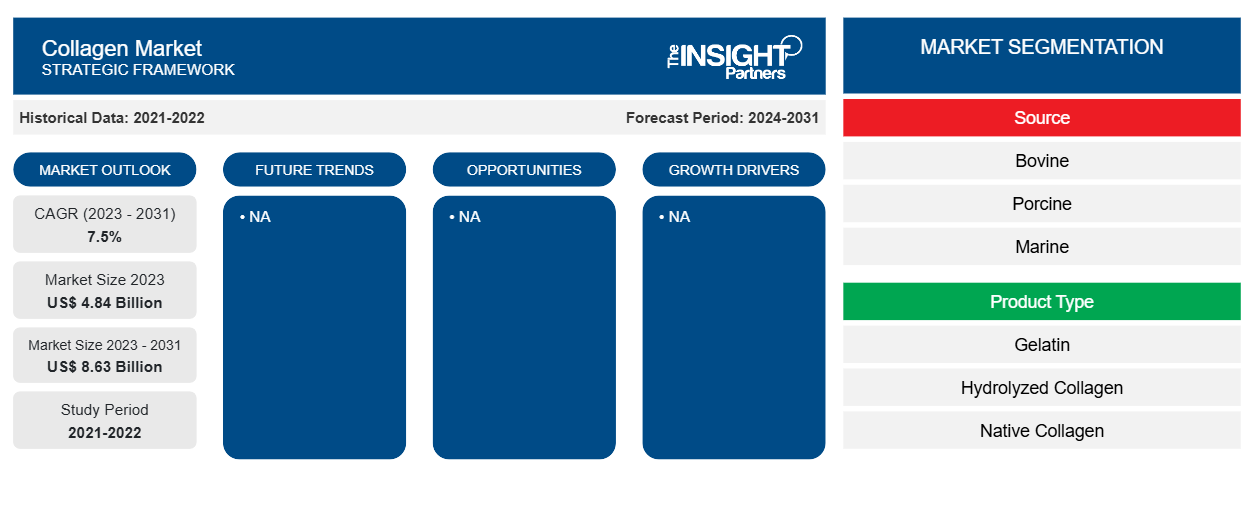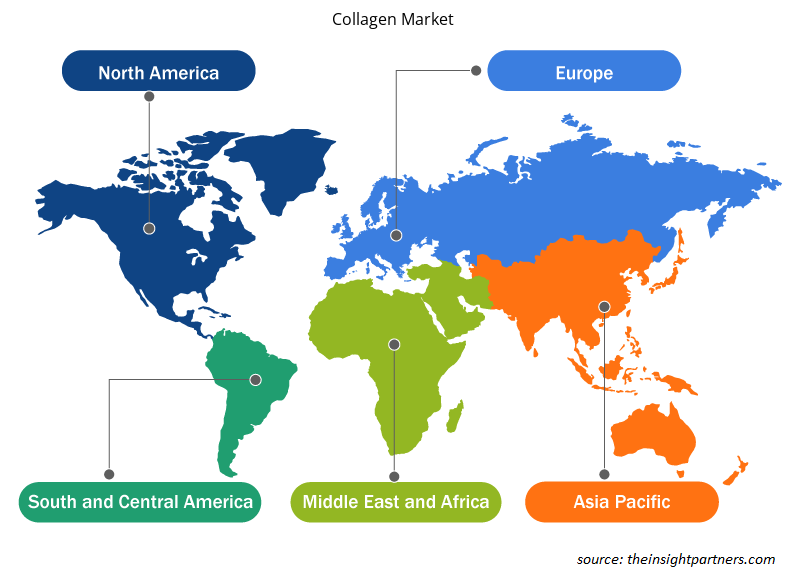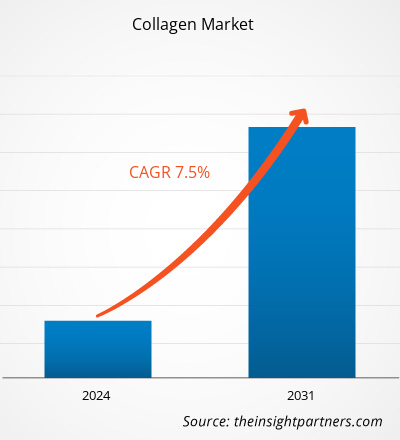Si prevede che il mercato del collagene raggiungerà i 7,76 miliardi di dollari entro il 2031, rispetto ai 5,50 miliardi di dollari del 2024. Si prevede che il mercato registrerà un CAGR del 5,1% nel periodo 2025-2031. L'aumento delle diete ricche di proteine probabilmente porterà nuove tendenze nel mercato durante il periodo di previsione.
Analisi del mercato del collagene
Innovazioni rivolte al consumatore nel mercato del collagene . Ad esempio, in collaborazione con Wellnex , Realize Collagen utilizza tecniche avanzate di idrolisi per creare peptidi di collagene con un assorbimento e una biodisponibilità migliorati . Questa innovazione migliora aspetti quali l'elasticità della pelle, la salute delle articolazioni e il recupero muscolare, con conseguenti migliori risultati e soddisfazione del consumatore. Questi progressi tecnologici affrontano anche le sfide del passato, tra cui l'immunogenicità , la qualità non uniforme e le preoccupazioni etiche, aprendo al contempo nuove possibilità per le applicazioni del collagene . Con la crescente consapevolezza della sostenibilità, della sicurezza sanitaria e del consumo etico, le tecnologie del collagene di origine vegetale e ricombinante sono pronte a ridefinire il futuro dell'industria del collagene. Man mano che i principali attori continuano a innovare e ad ampliare i propri portfolio, si prevede che la domanda di questi tipi di collagene di nuova generazione aumenterà costantemente, aprendo nuove opportunità di crescita nel mercato globale del collagene durante il periodo di previsione.
Panoramica del mercato del collagene
Si prevede che il mercato globale del collagene registrerà una crescita costante, trainata dalla crescente domanda in settori come quello alimentare e delle bevande, farmaceutico e cosmetico. Il collagene, noto per i suoi benefici funzionali per la salute, è ampiamente utilizzato negli integratori alimentari, nei prodotti per la cura della pelle e in applicazioni mediche. La crescente consapevolezza dei consumatori in materia di salute, benessere e invecchiamento è un fattore significativo che alimenta la domanda, in particolare per gli integratori alimentari a base di collagene e le formulazioni anti-età per la cura della pelle. Inoltre, la crescente popolazione geriatrica e la crescente prevalenza di malattie legate allo stile di vita contribuiscono alla traiettoria ascendente del mercato, poiché il collagene contribuisce alla salute, all'elasticità della pelle e alla riparazione dei tessuti.
Personalizza questo report in base alle tue esigenze
Riceverai la personalizzazione gratuita di qualsiasi report, incluse parti di questo report, analisi a livello nazionale, pacchetto dati Excel e potrai usufruire di fantastiche offerte e sconti per start-up e università.
Mercato del collagene: approfondimenti strategici

- Scopri le principali tendenze di mercato di questo rapporto.Questo campione GRATUITO includerà analisi di dati che spaziano dalle tendenze di mercato alle stime e alle previsioni.
Fattori trainanti e opportunità del mercato del collagene
Progressi tecnologici nell'estrazione e nella lavorazione
I progressi tecnologici nell'estrazione e nella lavorazione del collagene hanno trasformato significativamente l'efficienza, la purezza e il potenziale applicativo dei prodotti a base di collagene. Innovazioni come la tecnologia ricombinante , la fermentazione di precisione e l'idrolisi enzimatica ottimizzata hanno consentito lo sviluppo di soluzioni di collagene altamente biodisponibili , personalizzabili e sostenibili, adatte a un'ampia gamma di settori, tra cui quello medico, nutraceutico e cosmetico. Ad esempio, nel luglio 2024, Evonik VECOLLAN , un collagene ricombinante di nuova generazione , è stato prodotto attraverso un processo di fermentazione microbica controllata e priva di componenti animali. Offre un'eccezionale biocompatibilità e una costanza di produzione da lotto a lotto, fondamentali per applicazioni biomediche avanzate come la guarigione delle ferite, la rigenerazione tissutale e la biostampa 3D . VECOLLAN è progettato per diverse forme e opzioni di reticolazione, ampliando significativamente il potenziale funzionale del collagene oltre i formati tradizionali. Analogamente, CollPlant Biotechnologies ha sviluppato collagene umano ricombinante di origine vegetale ( rhCollagen ) utilizzando piante di tabacco geneticamente modificate. Questa piattaforma unica consente una produzione di collagene scalabile , sicura e sostenibile per la medicina estetica, la medicina rigenerativa e l'ortobiologia . Le partnership di CollPlant con leader del settore per lo sviluppo di impianti e prodotti estetici biostampati in 3D sottolineano la fattibilità commerciale e terapeutica di queste forme avanzate di collagene.
Innovazione nel collagene vegetale e ricombinante
Il collagene di origine vegetale e ricombinante offre soluzioni metabolicamente compatibili, eticamente consapevoli e prive di agenti patogeni, in linea con l'evoluzione delle preferenze dei consumatori e delle tendenze normative. Queste alternative sono adatte a consumatori vegani e vegetariani. Eliminano inoltre il rischio di malattie trasmissibili come l'encefalopatia spongiforme bovina (BSE) e le encefalopatie spongiformi trasmissibili (TSE), spesso associate al collagene derivato da animali terrestri. Inoltre, queste fonti superano le restrizioni culturali e religiose legate al collagene tradizionale, rendendole adatte a una fascia demografica globale più ampia.
I principali attori del settore stanno investendo in modo significativo in questo settore del collagene per capitalizzare sulla domanda. Ad esempio, Evonik, in partnership con Jland Biotech, ha investito nella produzione di collagene vegano attraverso la tecnologia di fermentazione di precisione. Questa mossa strategica mira a soddisfare la crescente domanda di ingredienti di collagene non di origine animale in applicazioni di bellezza e salute. Nel febbraio 2024, Evonik ha anche lanciato i suoi ingredienti di collagene vegano a base biotecnologica, specificamente progettati per prodotti per la cura di pelle e capelli, a ulteriore conferma della fattibilità commerciale e dell'attrattiva per i consumatori di queste innovazioni. Inoltre, nel maggio 2024, HTL Biotechnology ha acquisito la piattaforma di collagene umano ricombinante di Modern Meadow, che fornisce collagene derivato da biotecnologie. Ciò consente a HTL di rafforzare la propria presenza nei settori della bellezza e biomedico offrendo soluzioni di collagene scalabili e sostenibili, prodotte attraverso la biologia sintetica.
Analisi della segmentazione del rapporto di mercato del collagene
I segmenti chiave che hanno contribuito alla derivazione dell'analisi di mercato del collagene sono tipo di prodotto, fonte e applicazione.
- In base alla tipologia di prodotto, il mercato è segmentato in gelatina, collagene idrolizzato, collagene nativo, collagene sintetico e altri. Il segmento della gelatina deteneva la quota di mercato maggiore nel 2024.
- Il segmento di origine è suddiviso in bovini, suini, pollame, animali marini e altri. Si prevede che il segmento marino registrerà il CAGR più elevato dal 2025 al 2031.
- In base all'applicazione, il mercato del collagene è segmentato in alimenti e bevande, prodotti farmaceutici e nutraceutici, cura della persona e cosmetici, nutrizione animale, assistenza sanitaria e altri settori. Il segmento farmaceutico e nutraceutico ha detenuto la quota di mercato maggiore nel 2024.
Analisi della quota di mercato del collagene per area geografica
L'ambito geografico del mercato del collagene è principalmente suddiviso in cinque regioni: Nord America, Asia Pacifico, Europa, Medio Oriente e Africa, e Sud e Centro America.
L'Europa ha detenuto una quota di mercato significativa nel 2024. L'Europa è uno dei maggiori mercati al mondo per i prodotti da forno e il Regno Unito è tra i maggiori contributori nella regione. Secondo l'Annual Business Survey, l'industria della panificazione è stata uno dei maggiori settori manifatturieri, con un valore di 5,8 miliardi di dollari nel 2022. Ha contribuito a circa il 13% del valore aggiunto lordo totale nella produzione di alimenti e bevande. Il pane è il prodotto da forno in più rapida crescita nella regione. Secondo UK Flour Millers, il pane viene acquistato dal 99,8% delle famiglie britanniche e nel Regno Unito vengono venduti circa 11 milioni di pagnotte ogni giorno. Il collagene idrolizzato e la gelatina sono ampiamente utilizzati nella produzione di prodotti da forno. Ad esempio, vengono utilizzati per migliorare le proprietà di cottura e potenzialmente prolungare la durata di conservazione del pane, influenzando il processo di raffermamento. Il collagene viene aggiunto all'impasto in piccole quantità, migliorando la durezza della mollica, la consistenza e la struttura generale dei prodotti da forno.
La regione ha registrato una crescita significativa nel settore della cura della persona e dei cosmetici. L'Oréal ha dichiarato che nel 2022 l'Europa contava 575 milioni di consumatori dei suoi prodotti per la cura della persona e cosmetici. Si prevede che questo numero aumenterà di altri 40 milioni entro il 2030, trainato dal crescente numero di consumatori della classe media e medio-alta nella regione. L'Oréal e altre aziende di prodotti per la cura della persona e cosmetici utilizzano ampiamente il collagene nei loro prodotti per la cura della pelle. Ad esempio, L'Oréal offre la crema idratante Age Perfect Anti-Sagging + Even Tone Collagen Expert SPF 30 e altre creme idratanti al collagene. Pertanto, la crescente domanda di prodotti da forno e l'aumento delle vendite di prodotti per la cura della persona e cosmetici stimolano la crescita del mercato del collagene nella regione.
Approfondimenti regionali sul mercato del collagene
Le tendenze e i fattori regionali che influenzano il mercato del collagene durante il periodo di previsione sono stati ampiamente spiegati dagli analisti di Insight Partners. Questa sezione illustra anche i segmenti e la distribuzione geografica del mercato del collagene in Nord America, Europa, Asia-Pacifico, Medio Oriente e Africa, e Sud e Centro America.

- Ottieni i dati specifici regionali per il mercato del collagene
Ambito del rapporto sul mercato del collagene
| Attributo del report | Dettagli |
|---|---|
| Dimensioni del mercato nel 2024 | 5,50 miliardi di dollari USA |
| Dimensioni del mercato entro il 2031 | 7,76 miliardi di dollari USA |
| CAGR globale (2025-2031) | 5,1% |
| Dati storici | 2021-2023 |
| Periodo di previsione | 2025-2031 |
| Segmenti coperti | Per tipo di prodotto
|
| Regioni e paesi coperti | America del Nord
|
| Leader di mercato e profili aziendali chiave |
|
Densità degli operatori del mercato del collagene: comprendere il suo impatto sulle dinamiche aziendali
Il mercato del collagene è in rapida crescita, trainato dalla crescente domanda da parte degli utenti finali, dovuta a fattori quali l'evoluzione delle preferenze dei consumatori, i progressi tecnologici e una maggiore consapevolezza dei benefici del prodotto. Con l'aumento della domanda, le aziende stanno ampliando la propria offerta, innovando per soddisfare le esigenze dei consumatori e capitalizzando sulle tendenze emergenti, alimentando ulteriormente la crescita del mercato.
La densità degli operatori di mercato si riferisce alla distribuzione delle imprese che operano in un determinato mercato o settore. Indica quanti concorrenti (operatori di mercato) sono presenti in un determinato spazio di mercato in relazione alle sue dimensioni o al suo valore totale.
Le principali aziende che operano nel mercato del collagene sono:
- GELITA AG
- Rousselot BV
- Titan Biotech Ltd
- Tessenderlo Group NV
- Ewald-Gelatine GmbH
- BioCell Technology LLC
Disclaimer : le aziende elencate sopra non sono classificate secondo alcun ordine particolare.

- Ottieni una panoramica dei principali attori del mercato del collagene
Notizie e sviluppi recenti sul mercato del collagene
Il mercato del collagene viene valutato raccogliendo dati qualitativi e quantitativi post-ricerca primaria e secondaria, che includono importanti pubblicazioni aziendali, dati di associazioni e database. Di seguito è riportato uno sviluppo chiave nel mercato del collagene:
- Il produttore spagnolo di budelli per carne Viscofan Group ha acquisito una quota di maggioranza del 51% del produttore brasiliano di alimenti per animali domestici Pet Mania Comércio Internacional per 5,6 milioni di euro (5,8 milioni di dollari). Pet Mania produce e vende snack di origine animale per animali domestici, tra cui Porpeta, Beef Sticks, Meat Knots e Collagen Donuts. (Fonte: Viscofan Group, Newsletter, febbraio 2025)
Copertura e risultati del rapporto sul mercato del collagene
Il rapporto "Dimensioni e previsioni del mercato del collagene (2021-2031)" fornisce un'analisi dettagliata del mercato che copre le seguenti aree:
- Quota di mercato del collagene e previsioni a livello globale, regionale e nazionale per tutti i principali segmenti di mercato coperti dall'ambito
- Tendenze del mercato del collagene, nonché dinamiche di mercato come fattori trainanti, vincoli e opportunità chiave
- Analisi dettagliata delle cinque forze di Porter e analisi SWOT
- Mercato del collagene che copre le principali tendenze del mercato, il quadro globale e regionale, i principali attori, le normative e i recenti sviluppi del mercato
- Analisi del panorama industriale e della concorrenza che copre la concentrazione del mercato, l'analisi della mappa di calore, i principali attori e gli sviluppi recenti per il mercato del collagene
- Profili aziendali dettagliati
- Analisi storica (2 anni), anno base, previsione (7 anni) con CAGR
- Analisi PEST e SWOT
- Valore/volume delle dimensioni del mercato - Globale, Regionale, Nazionale
- Industria e panorama competitivo
- Set di dati Excel
Report recenti
Testimonianze
Motivo dell'acquisto
- Processo decisionale informato
- Comprensione delle dinamiche di mercato
- Analisi competitiva
- Analisi dei clienti
- Previsioni di mercato
- Mitigazione del rischio
- Pianificazione strategica
- Giustificazione degli investimenti
- Identificazione dei mercati emergenti
- Miglioramento delle strategie di marketing
- Aumento dell'efficienza operativa
- Allineamento alle tendenze normative




















 Ottieni un campione gratuito per - Mercato del collagene
Ottieni un campione gratuito per - Mercato del collagene